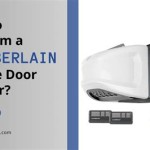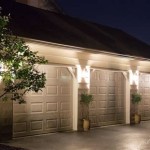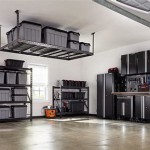How to Paint an Old Metal Garage Door
Painting an old metal garage door is a cost-effective way to enhance curb appeal and protect the door from further deterioration. Over time, exposure to the elements can lead to rust, fading, and general wear and tear. A fresh coat of paint can not only revitalize the appearance of the door but also provide a protective barrier against future damage. This article provides a comprehensive guide on how to properly prepare and paint an old metal garage door, ensuring a professional and long-lasting finish.
Key Point 1: Preparation is Paramount
Proper preparation is the most crucial step in achieving a successful and durable paint job. Neglecting this stage can lead to peeling, chipping, and an overall uneven finish. The process involves thorough cleaning, rust removal, and priming to create a suitable surface for the new paint to adhere to.
Cleaning the Garage Door: The first step is to remove any loose debris, dirt, and grime from the garage door. This can be achieved with a stiff brush or broom. Once the loose particles are removed, wash the entire surface of the door with a mixture of warm water and a degreasing detergent. Automotive degreasers work exceptionally well for this purpose, as they are designed to remove grease and oil buildup. Use a sponge or soft cloth to scrub the door thoroughly, paying close attention to areas with heavy grime or stains. Rinse the door completely with clean water, ensuring that all traces of the detergent are removed. Any remaining detergent can interfere with the paint's adhesion.
Rust Removal: Old metal garage doors are often susceptible to rust. Before painting, all rust must be removed to prevent it from spreading and compromising the new paint job. There are several methods for removing rust, each with its own advantages and disadvantages. One common method is using a wire brush or sandpaper. For light rust, a medium-grit sandpaper (around 120-grit) can be sufficient. For more severe rust, a coarser grit (around 80-grit) or a wire brush may be necessary. Wear safety glasses and gloves when using these tools, as rust particles can be harmful.
Alternatively, chemical rust removers can be used. These products typically contain acids that dissolve rust. Follow the manufacturer's instructions carefully, as these chemicals can be corrosive. Always wear appropriate protective gear, including gloves, safety glasses, and a respirator, when working with chemical rust removers. After applying the rust remover, scrub the affected area with a wire brush or scouring pad, and then rinse thoroughly with water.
For extensive rust damage, power tools such as a grinder with a rust removal attachment or a sandblaster may be necessary. These tools can quickly remove large areas of rust, but they also require caution and experience to use safely. Always wear appropriate safety gear and follow the manufacturer's instructions when using power tools.
Priming the Garage Door: Once the door is thoroughly cleaned and all rust has been removed, it is crucial to apply a primer. Primer serves several important functions: it creates a uniform surface for the paint to adhere to, it seals porous surfaces, and it provides a barrier against rust. Choose a primer specifically designed for metal surfaces, preferably a rust-inhibiting primer. Apply the primer in thin, even coats, using a brush, roller, or sprayer. Allow the primer to dry completely according to the manufacturer's instructions before proceeding to the next step. Two coats of primer may be necessary for heavily rusted or pitted surfaces. Lightly sand the primed surface with fine-grit sandpaper (around 220-grit) to smooth out any imperfections before painting.
Key Point 2: Choosing the Right Paint and Application Method
Selecting the appropriate type of paint and application method is essential for achieving a durable and aesthetically pleasing finish. The choice of paint should be based on factors such as the type of metal, the desired finish, and the environmental conditions.
Selecting the Right Paint: For metal garage doors, an exterior-grade acrylic latex paint is generally the best choice. Acrylic latex paints are durable, weather-resistant, and provide excellent adhesion to metal surfaces. They are also relatively easy to apply and clean up. Oil-based paints were once a popular choice for metal surfaces, but they are now less common due to stricter environmental regulations and the availability of high-quality acrylic latex alternatives. If opting for an oil-based paint, ensure it is compatible with the primer used. Consider the desired finish when selecting paint. Options include gloss, semi-gloss, satin, and matte. Gloss and semi-gloss finishes are more durable and easier to clean, making them suitable for high-traffic areas. Satin and matte finishes offer a more subtle look and can help to hide imperfections, but they may be less resistant to dirt and grime.
Choosing the Right Color: The color choice should complement the style of the house and the surrounding environment. Lighter colors tend to reflect sunlight and can help to keep the garage cooler, while darker colors absorb heat and can make the garage warmer. Consider the impact of fading when choosing a color. Darker colors tend to fade more quickly than lighter colors. Before committing to a particular color, test it on a small, inconspicuous area of the garage door to ensure it looks as expected. It is beneficial to consult with local homeowner association guidelines or neighborhood covenants regarding acceptable paint colors.
Paint Application Methods: There are three primary methods for applying paint to a garage door: brushing, rolling, and spraying. Each method has its own advantages and disadvantages.
Brushing: Brushing is a traditional method that allows for precise application, especially in tight corners and around details. However, brushing can be time-consuming and may leave brush marks on the surface. Use a high-quality brush with synthetic bristles for acrylic latex paints. Apply the paint in thin, even strokes, overlapping each stroke slightly to avoid gaps.
Rolling: Rolling is a faster and more efficient method for painting large, flat surfaces. Use a high-density foam roller for a smooth, even finish. Apply the paint in a "W" or "M" pattern, and then roll over the area to spread the paint evenly. Avoid applying too much pressure, as this can create roller marks. A small brush can be used to touch up any areas that the roller cannot reach.
Spraying: Spraying provides the smoothest and most professional-looking finish, but it also requires more skill and preparation. Use a paint sprayer specifically designed for exterior painting. Thin the paint according to the manufacturer's instructions to ensure it flows properly through the sprayer. Apply the paint in thin, even coats, overlapping each coat slightly. Maintain a consistent distance from the surface of the door to avoid drips and runs. Spraying requires careful masking to protect surrounding areas from overspray. Wear a respirator and eye protection when spraying paint.
Key Point 3: Achieving a Professional Finish
The final steps in painting a metal garage door are crucial for achieving a professional and long-lasting finish. This involves applying multiple coats of paint, allowing sufficient drying time, and addressing any imperfections.
Applying Multiple Coats: Applying multiple thin coats of paint is generally better than applying one thick coat. Thin coats dry more evenly and are less likely to sag or run. Allow each coat to dry completely according to the manufacturer's instructions before applying the next coat. Lightly sand the surface between coats with fine-grit sandpaper (around 220-grit) to smooth out any imperfections and improve adhesion. Two coats of paint are typically sufficient for most garage doors, but three coats may be necessary for heavily weathered or textured surfaces.
Drying Time: Allowing sufficient drying time is essential for ensuring a durable and long-lasting paint job. The drying time will vary depending on the type of paint, the temperature, and the humidity. Follow the manufacturer's instructions for recommended drying times. Avoid exposing the freshly painted door to rain or direct sunlight during the drying process. A ventilated environment will promote faster and more even drying.
Addressing Imperfections: Even with careful preparation and application, imperfections may still occur. Drips, runs, and sags can be corrected by lightly sanding the affected area and applying a thin coat of paint. Brush marks can be minimized by feathering out the edges of the paint with a clean brush. Dust and debris can be removed by carefully wiping the surface with a tack cloth before applying each coat of paint. Inspect the finished door for any missed spots or areas that require touch-up. Apply additional paint as needed to achieve a uniform and flawless finish.
Maintaining the Painted Garage Door: Once the garage door is painted, regular maintenance will help to preserve its appearance and extend its lifespan. Wash the door periodically with mild soap and water to remove dirt and grime. Inspect the door regularly for signs of rust or damage, and address any issues promptly. Applying a coat of clear sealant every few years can provide additional protection against the elements. Following these guidelines ensures long lasting and aesthetically pleasing garage door.

How To Paint A Metal Garage Door Doodledash Vintage Home

Painting A Steel Garage Door Worcester Company

How To Paint A Metal Garage Door In 7 Simple Steps

A Tutorial For Painting Garage Door Young House Love

How To Paint A Steel Or Aluminum Garage Door Blog

How To Paint Garage Doors Pro For Perfect

How To Paint A Metal Garage Door Diy Doctor

Garage Door Makeover With Paint

How To Paint Galvanized Metal Garage Doors

A Tutorial For Painting Garage Door Young House Love
Related Posts








